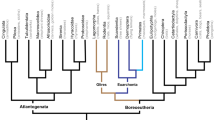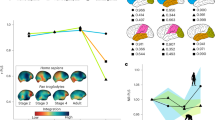Abstract
The mammalian brain is composed of several distinct parts which show different growth in evolution. Clark, Mitra and Wang1 found that the two main cortices of the brain — the cerebral (neo-) cortex and the cerebellum — show very different growth, and that whereas the ratio of neocortex volume to total brain volume increases with evolution, the cerebellum occupies a constant proportion in different species. Here I compare the surface areas of the two cortices in different species and find that these show a simple proportionality. Contrary to the conclusion drawn by Clark et al.1, this linear dependence of size implies that the two major cortices increase their computational capacity in parallel, suggesting a functional dependence of the one upon the other.
This is a preview of subscription content, access via your institution
Access options
Subscribe to this journal
Receive 51 print issues and online access
$199.00 per year
only $3.90 per issue
Buy this article
- Purchase on Springer Link
- Instant access to full article PDF
Prices may be subject to local taxes which are calculated during checkout

Similar content being viewed by others
References
Clark, D. A., Mitra, P. P. & Wang, S. S. Nature 411, 189–193 (2001).
Matano, S., Stephan, H. & Baron, G. Folia Primatol. 44, 171–181 (1985).
Hofman, M. A. Brain Behav. Evol. 27, 28–40 (1985).
Frahm, H. D., Stephan, H. & Stephan, M. J. Hirnforsch. 23, 375–389 (1982).
Korbo, L., Andersen, B. B., Ladefoged, O. & Moller, A. Brain Res. 609, 262–268 (1993).
Andersen, B. B., Korbo, L. & Pakkenberg, B. J. Comp. Neurol. 326, 549–560 (1992).
Braitenberg, V. J. Comput. Neurosci. 10, 71–77 (2001).
Zhang, K. & Sejnowski, T. J. Proc. Natl Acad. Sci. USA 97, 5621–5626 (2000).
Braitenberg, V. & Schüz, A. Anatomy of the Cortex (Springer, Berlin, 1991).
Braitenberg, V., Heck, D. & Sultan, F. Behav.Brain Sci. 20, 229–245 (1997).
Sultan, F. & Braitenberg, V. J. Hirnforsch. 34, 79–92 (1993).
Brodmann, K. Verhandlungen der 85. Versammlung deutscher Naturforscher und Ärzte in Wien 85, 200–240 (1913).
Author information
Authors and Affiliations
Corresponding author
Rights and permissions
About this article
Cite this article
Sultan, F. Analysis of mammalian brain architecture. Nature 415, 133–134 (2002). https://doi.org/10.1038/415133b
Issue Date:
DOI: https://doi.org/10.1038/415133b
This article is cited by
-
Indices of comparative cognition: assessing animal models of human brain function
Experimental Brain Research (2018)
-
Contralateral cortico-ponto-cerebellar pathways reconstruction in humans in vivo: implications for reciprocal cerebro-cerebellar structural connectivity in motor and non-motor areas
Scientific Reports (2017)
-
Contralateral cerebello-thalamo-cortical pathways with prominent involvement of associative areas in humans in vivo
Brain Structure and Function (2015)
-
The Emotional Cerebellum
The Cerebellum (2015)
-
Deficits of cortical oculomotor mechanisms in cerebellar atrophy patients
Experimental Brain Research (2013)
Comments
By submitting a comment you agree to abide by our Terms and Community Guidelines. If you find something abusive or that does not comply with our terms or guidelines please flag it as inappropriate.



